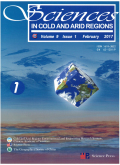- 钛学术文献服务平台 \
- 学术期刊 \
- 基础科学期刊 \
- 天文学、地球科学期刊 \
- 寒旱区科学(英文版)期刊 \
Thickness estimation of the Longbasaba Glacier:methods and application
Thickness estimation of the Longbasaba Glacier:methods and application
基本信息来源于合作网站,原文需代理用户跳转至来源网站获取
摘要:
A total of 71,177 glaciers exist on the Qinghai-Tibet Plateau, according to the Randolph Glacier Inventory (RGI 6.0). De-spite their large number, glacier ice thickness data are relatively scarce. This study utilizes digital elevation model data and ground-penetrating radar thickness measurements to estimate the distribution and variation of ice thickness of the Longba-saba Glacier using Glacier bed Topography (GlabTop), a full-width expansion model, and the Huss and Farinotti (HF) model. Results show that the average absolute deviations of GlabTop, the full-width expansion model, and the HF model are 9.8, 15.5, and 10.9 m, respectively, indicating that GlabTop performs the best in simulating glacier thickness distribu-tion. During 1980-2015, the Longbasaba Glacier thinned by an average of 7.9±1.3 m or 0.23±0.04 m/a, and its ice volume shrunk by 0.28±0.04 km3 with an average reduction rate of 0.0081±0.0001 km3/a. In the investigation period, the area and volume of Longbasaba Lake expanded at rates of 0.12±0.01 km2/a and 0.0132±0.0018 km3/a, respectively. This proglacial lake could potentially extend up to 5,000 m from the lake dam.

推荐文章
Application of K-means and PCA approaches to estimation of gold grade in Khooni district (central Ir
K-means method
Clustering
Principal
component analysis (PCA)
Estimation
Gold
Khooni district
Estimation of soil organic carbon storage and its fractions in a small karst watershed
Bare rock rate
Estimation method
soil organic carbon storage
Small watershed
Karst
Source and yearly distribution of PAHs in the snow from the Hailuogou glacier of Mountain Gongga, Ch
PAHs
Snow
Source
Distribution
GC-MS
Hailuogou of Mt. Gongga
Application ontology构建及SPARQL查询研究
本体
手机应用
简单协议和RDF查询语言
查询
本体描述语言
内容分析
关键词云
关键词热度
相关文献总数
(/次)
(/年)
文献信息
| 篇名 | Thickness estimation of the Longbasaba Glacier:methods and application | ||
| 来源期刊 | 寒旱区科学(英文版) | 学科 | |
| 关键词 | |||
| 年,卷(期) | 2020,(6) | 所属期刊栏目 | Articles |
| 研究方向 | 页码范围 | 477-490 | |
| 页数 | 14页 | 分类号 | |
| 字数 | 语种 | 英文 | |
| DOI | |||
五维指标
引文网络
引文网络
二级参考文献 (111)
共引文献 (84)
参考文献 (30)
节点文献
引证文献 (0)
同被引文献 (0)
二级引证文献 (0)
1986(1)
- 参考文献(0)
- 二级参考文献(1)
1989(1)
- 参考文献(0)
- 二级参考文献(1)
1991(1)
- 参考文献(0)
- 二级参考文献(1)
1992(1)
- 参考文献(0)
- 二级参考文献(1)
1998(2)
- 参考文献(0)
- 二级参考文献(2)
1999(1)
- 参考文献(0)
- 二级参考文献(1)
2000(5)
- 参考文献(0)
- 二级参考文献(5)
2001(3)
- 参考文献(0)
- 二级参考文献(3)
2002(8)
- 参考文献(0)
- 二级参考文献(8)
2003(4)
- 参考文献(0)
- 二级参考文献(4)
2004(5)
- 参考文献(1)
- 二级参考文献(4)
2005(8)
- 参考文献(0)
- 二级参考文献(8)
2006(7)
- 参考文献(0)
- 二级参考文献(7)
2007(7)
- 参考文献(0)
- 二级参考文献(7)
2008(11)
- 参考文献(0)
- 二级参考文献(11)
2009(4)
- 参考文献(0)
- 二级参考文献(4)
2010(9)
- 参考文献(1)
- 二级参考文献(8)
2011(12)
- 参考文献(0)
- 二级参考文献(12)
2012(15)
- 参考文献(6)
- 二级参考文献(9)
2013(12)
- 参考文献(5)
- 二级参考文献(7)
2014(5)
- 参考文献(0)
- 二级参考文献(5)
2015(4)
- 参考文献(2)
- 二级参考文献(2)
2016(2)
- 参考文献(2)
- 二级参考文献(0)
2017(6)
- 参考文献(6)
- 二级参考文献(0)
2018(4)
- 参考文献(4)
- 二级参考文献(0)
2019(1)
- 参考文献(1)
- 二级参考文献(0)
2020(2)
- 参考文献(2)
- 二级参考文献(0)
2020(2)
- 参考文献(2)
- 二级参考文献(0)
- 引证文献(0)
- 二级引证文献(0)
引文网络交叉学科
相关学者/机构
期刊影响力
寒旱区科学(英文版)
主办单位:
中国科学院寒区旱区环境与工程研究所
科学出版社有限责任公司
出版周期:
双月刊
ISSN:
1674-3822
CN:
62-1201/P
开本:
出版地:
甘肃省兰州市东岗西路320号
邮发代号:
创刊时间:
语种:
eng
出版文献量(篇)
870
总下载数(次)
0
总被引数(次)
1072
期刊文献
相关文献
推荐文献
- 期刊分类
- 期刊(年)
- 期刊(期)
- 期刊推荐
力学
化学
地球物理学
地质学
基础科学综合
大学学报
天文学
天文学、地球科学
数学
气象学
海洋学
物理学
生物学
生物科学
自然地理学和测绘学
自然科学总论
自然科学理论与方法
资源科学
非线性科学与系统科学
寒旱区科学(英文版)2022
寒旱区科学(英文版)2021
寒旱区科学(英文版)2020
寒旱区科学(英文版)2019
寒旱区科学(英文版)2018
寒旱区科学(英文版)2017
寒旱区科学(英文版)2016
寒旱区科学(英文版)2015
寒旱区科学(英文版)2014
寒旱区科学(英文版)2013
寒旱区科学(英文版)2012
寒旱区科学(英文版)2011
寒旱区科学(英文版)2010
寒旱区科学(英文版)2009
寒旱区科学(英文版)2008
寒旱区科学(英文版)2020年第6期
寒旱区科学(英文版)2020年第5期
寒旱区科学(英文版)2020年第4期
寒旱区科学(英文版)2020年第3期
寒旱区科学(英文版)2020年第2期
寒旱区科学(英文版)2020年第1期

 免费查重
免费查重










